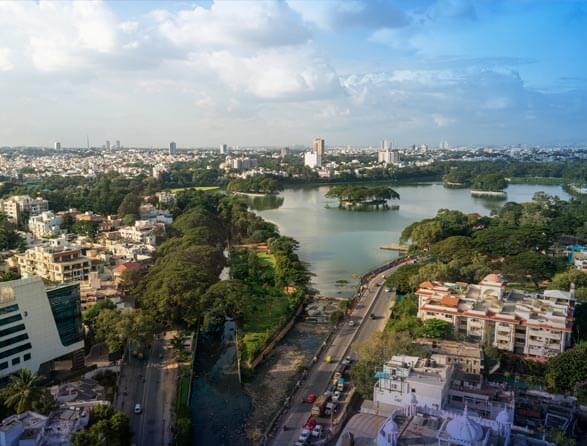Finding ways to create more sustainable cities is an important challenge, especially with the massive growth rates projected for the 28 megacities that already have 10 million residents or more. As these cities grow, so will their challenges. Which means that experts worldwide are evaluating better ways to make them green, clean and livable.
Sustainable cities tend to have three characteristics: they are designed to optimize 1) social, 2) economic and 3) environmental impacts.
So, how much do you know about sustainable cities? Here’s your chance to measure your knowledge and learn more! Quiz yourself on our questions and scroll down to find the answers below.
Want to learn more about sustainable cities? Check out the Urban Renaissance Act, part of The Only Progress is Human initiative.

- Generally, what is the most sustainable size for a community?
A. Low-density rural areas B. Medium-sized towns C. Small cities D. Large cities

2. Globally, more people lived in rural areas than in cities until what year, according to the United Nations (UN)?
A. 1957 B. 1997 C. 2007 D. 2017
3. Today, the UN estimates that about 55% of the world’s population lives in cities. By 2050, the UN projects that cities’ share of the global population will be approximately:
A. 47% B. 60% C. 70% D. 80%

4. According to the Global Livability Index compiled by Economist Intelligence Unit for 2022, what is the world’s most sustainable city?
A. Vienna, Austria B. Zurich, Switzerland C. Vancouver, Canada C. Auckland, New Zealand
5. Today, the world’s most populous city is Tokyo, Japan. Which city is projected to have the largest population by 2035?
A. Jakarta, Indonesia B. Mexico City, Mexico C. Tokyo, Japan D. Shanghai, China

6. Which is the world’s fastest-growing city?
A. Dhaka, Bangladesh B. Jakarta, Indonesia C. Mexico City, Mexico D. Bengaluru, India
7. Where has the concept of “material circularity” – recycling more, reusing materials in new products, and embracing renewable energy – been enshrined in the local constitution?
A. Bonn, Germany B. Paris, France C. Zurich, Switzerland D. San Francisco, California

8. Buildings (construction and operations) are responsible for what percentage of global greenhouse gas emissions?
A. 10% B. 25% C. 33% D. 50%
9. The World Economic Forum (WEF) reports that modern designs and off-the-shelf technology can reduce greenhouse gas emissions from new buildings by how much?
A. 10% B. 25% C. 33% D. 50%

10. The World Resources Institute recognized this city for integrating building energy-performance practices into its local building codes:
A. Zurich, Switzerland B. Mexico City, Mexico C. San Francisco, California D. Tokyo, Japan
- Generally, what is the most sustainable size for a community?
D, Large cities In an interview with the World Economic Forum in 2016, then-executive director of UN Habitat, Joan Clos, noted that most studies show efficiency increases along with the size of a city. The correlation with Gross Domestic Product is even stronger, however, and performance can vary widely based on regulations, culture and other difficult-to-measure variables. In 2022, biofriendlyplanet.com also chose cities as more sustainable due to population density, public transport and superior water quality.
2. Globally, more people lived in rural areas than in cities until what year, according to the United Nations (UN)?
C, 2007 Before 2007, more of the world’s people lived in rural areas than in urban ones. By the beginning of 2007, the UN estimates that the ratio was roughly 50-50. So, at some point during 2007, the UN estimates that city dwellers outnumbered rural ones for the first time in human history.
3. Today, the UN estimates that about 55% of the world’s population lives in cities. By 2050, the UN projects that cities’ share of the global population will be approximately:
C, 70% The UN estimates that, by 2050, 68-70% of the world’s entire population will live in cities.
4. According to the Global Livability Index compiled by Economist Intelligence Unit for 2022, what is the world’s most sustainable city?
A, Vienna, Austria The Oxford Intelligence Unit’s 2022 Global Livability Index ranked Vienna, Austria, as the world’s most livable city, based on a combined 95.1/100 score for its stability, healthcare, culture & environment, education and infrastructure. The rest of the top 5: Copenhagen, Denmark; Zurich, Switzerland; and two cities in Canada: Calgary and Vancouver. Aukland, New Zealand, chosen as the world’s most livable city in 2018 and 2019, fell to #34 in 2022 due to high COVID infection rate.
5. Today, the world’s most populous city is Tokyo, Japan. Which city is projected to have the largest population by 2035?
A, Jakarta, Indonesia The World Economic Forum (WEF) reports that Jakarta will have the world’s largest population by 2035, based on a forecast by Oxford Economics, which projects the city-proper will have 38 million residents. However, Jakarta is sinking due to rising sea levels and poor water infrastructure, threatening its growth. Others in the Top 5 will be Tokyo, Japan, 37.8 million; Chongqing, China, 32.2 million; Dhaka, Bangladesh, 31.2 million; and Shanghai, China, 25.3 million.
6. Which is the world’s fastest-growing city?
D, Bengaluru, India Based again on Oxford Economics projections, the WEF reports that Bengaluru will be the world’s fastest-growing city by 2035 by population, growing at an annual rate of 8.5%. The rest of the top five are: Dhaka, Bangladesh, 7.6%; Mumbai, India, 6.6%; Delhi, India, 6.5%; and Shenzhen, China, 5.3%.
7. Where has the concept of “material circularity” – recycling more, reusing materials in new products, and embracing renewable energy – been enshrined in the local constitution?
C, Zurich, Switzerland In September 2022, 90% of the citizens of the canton of Zurich voted to implement a new circular-economy goal as part of its constitution. Zurich is the largest of Switzerland’s 26 cantons, and the first to take this action.
8. Buildings (construction and operations) are responsible for what percentage of global greenhouse gas emissions?
D, 50% Architecture 2030 reports than buildings are responsible for nearly half of all greenhouse gas emissions, including 27% from operations and 20% from construction and materials.
9. The World Economic Forum (WEF) reports that modern designs and off-the-shelf technology can reduce greenhouse gas emissions from new buildings by how much?
D, 50% An article posted by the World Economic Forum estimates that integrated designs and off-the-shelf technologies can reduce new buildings’ energy use by 50%.
10. The World Resources Institute recognized this city for integrating building energy-performance practices into its local building codes:
B, Mexico City, Mexico In 2016, Mexico City became the first to integrate building energy-performance practices into its building codes, the World Resources Institute reports.

